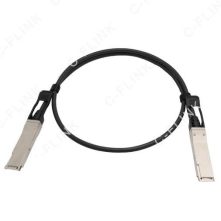Exploring the 200G QSFP56 DAC Straight Copper Cable: A Key Component in High-Speed Networking
Published:
2024-09-19
Among the various solutions available, the 200G QSFP56 Direct Attach Copper (DAC) cable has emerged as a crucial component in meeting the challenges posed by modern networking requirements.

In the rapidly evolving landscape of data communication, the demand for high-speed connectivity continues to grow. Among the various solutions available, the 200G QSFP56 Direct Attach Copper (DAC) cable has emerged as a crucial component in meeting the challenges posed by modern networking requirements.

The 200G QSFP56 DAC cable is designed to transmit data at speeds up to 200 gigabits per second (Gbps). This cable features a quad small form-factor pluggable (QSFP) connector, which allows for the integration of multiple channels within a single unit. Specifically, the QSFP56 variant supports four lanes of 50 Gbps each, enabling high-bandwidth data transfer over short distances.
DAC cables are typically constructed using copper conductors, making them cost-effective and efficient for short-range applications. Unlike optical cables, which convert electrical signals into light signals for transmission, DAC cables maintain electrical signaling throughout the connection. This results in lower latency and reduced power consumption, vital factors in data center environments.
Key Features of the 200G QSFP56 DAC Cable
High Bandwidth: With a data rate of 200 Gbps, the QSFP56 DAC cable can handle heavy workloads and high-volume data transfers, making it ideal for data centers, cloud computing, and high-performance computing environments.
Cost-Effectiveness: DAC cables are generally more affordable than their optical counterparts, providing an economical solution for interconnectivity in data centers and enterprise networks.
Ease of Installation: The plug-and-play design of the QSFP56 DAC cable simplifies installation and maintenance. Network administrators can quickly connect or disconnect devices without the need for specialized tools.
Low Latency: Because DAC cables use electrical signaling, they offer lower latency compared to optical cables. This characteristic is particularly beneficial in applications requiring real-time data processing and quick response times.
Energy Efficiency: The power consumption of DAC cables is significantly lower than that of optical cables, contributing to overall energy savings in large-scale data centers.
Applications of the 200G QSFP56 DAC Cable
1. Data Centers
One of the primary applications of the 200G QSFP56 DAC cable is in data centers where high-speed connectivity is essential for handling large volumes of data traffic. These cables facilitate connections between servers, switches, and storage devices, ensuring efficient data transfer and minimal latency.
2. Cloud Computing
As businesses increasingly migrate to cloud-based solutions, the need for robust and fast networking solutions has intensified. The 200G QSFP56 DAC cable provides the high bandwidth necessary for cloud computing environments, enabling seamless access to data and applications hosted in remote data centers.
3. High-Performance Computing (HPC)
In high-performance computing applications, where complex simulations and data analysis are performed, the speed and efficiency of data transmission are critical. The 200G QSFP56 DAC cable supports the demanding bandwidth requirements of HPC systems, ensuring that data is processed and transmitted without bottlenecks.
4. Enterprise Networks
Modern enterprises require reliable and fast networking solutions to support their operations. The 200G QSFP56 DAC cable is suitable for use in enterprise networks, particularly in scenarios where high-speed connections are needed between core switches and edge devices.

Scan
Huizhou C-FLINK Technology Co.,Ltd.
Add:No. 7 Guangtai Road, Huinan High tech Industrial Park, Zhongkai High tech Zone, Huizhou
Tel:0752-3272990
Fax:0752-3288515
E-mail:sales01@c-flink.com
Copyright © Huizhou C-FLINK Technology Co.,Ltd.
